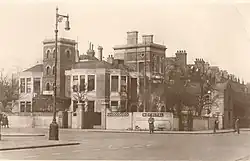Battersea General Hospital
| Battersea General Hospital | |
|---|---|
 Battersea General Hospital | |
 Location within Wandsworth | |
| Geography | |
| Location | Battersea, London, England, United Kingdom |
| Coordinates | 51°28′30″N 0°09′50″W / 51.4751°N 0.1640°W |
| History | |
| Opened | 1902 |
| Closed | 1972 |
| Links | |
| Lists | Hospitals in England |
Battersea General Hospital (founded as the National Anti-Vivisection Hospital) known locally as the "Antiviv" or the "Old Anti," was a hospital in Battersea, London.
History
In the 1890s the National Anti-Vivisection Society had organized a charitable trust with Lords Coleridge, Lord Hatherton, Ernest Bell, Abiathar Wall and Rev. Augustus Jackson as trustees to raise money for the creation of an anti-vivisection hospital.[1] The hospital was founded by Mrs Theodore Russell Monroe, secretary of the Anti-Vivisection Society as the National Anti-Vivisection Hospital in 1896.[2][a] The hospital was founded "for the relief of human suffering by physicians and surgeons who are opposed to vivisection".[2]
The hospital was notable for not allowing animal experiments to take place in its facilities, and for refusing to employ physicians who were involved in or approved of animal research.[2]
Based at 33 Prince of Wales Drive, Battersea Park, it first opened for in-patients in 1903, with 11 beds for adults and 4 for children. It faced opposition from the medical establishment, who regarded the hospital's existence as "a great slur upon the profession."[4] In 1908, Herbert Snow was appointed surgeon to the hospital.[5] The hospital registered as a business in 1910 and adopted the motto Delenda est Crudelitas — Cruelty Must Be Destroyed.[1] In 1911, a new twelve bed cancer research department was opened under the direction of Robert Bell.[1]
Because of difficulties attracting funding – its stance made it ineligible for grants from the King Edward's Hospital Fund – it lost its anti-vivisection charter in 1935. It joined the new National Health Service (NHS) in 1948, was closed by the NHS in 1972, and its building was demolished in 1974.[2]
See also
Notes
References
- ^ a b c Bates, A. W. H. (2017). "The National Anti-Vivisection Hospital, 1902–1935". In Anti-Vivisection and the Profession of Medicine in Britain: A Social History. Palgrave. ISBN 978-1137556967
- ^ a b c d "Battersea General Hospital". Lost hospitals of London. Retrieved 4 November 2020.
- ^ "A Notable Streatham Resident". The Streatham News. 6 February 1914. p. 5.
- ^ Kean, Hilda. "The 'Smooth Cool Men of Science': The Feminist and Socialist Response to Vivisection", History Workshop Journal, 1995, 40, p. 22.
- ^ Neuhaus, Susan J. (2004). "Dr. Herbert Lumley Snow, MD, MRCS (1847–1930): The Original Champion of Elective Lymph Node Dissection in Melanoma". Annals of Surgical Oncology. 11 (9): 875–878. doi:10.1245/ASO.2004.02.031. PMID 15342349. S2CID 29746326.
Further reading
- Lansbury, Coral. The Old Brown Dog: Women, Workers, and Vivisection in Edwardian England. University of Wisconsin Press, 1985.
